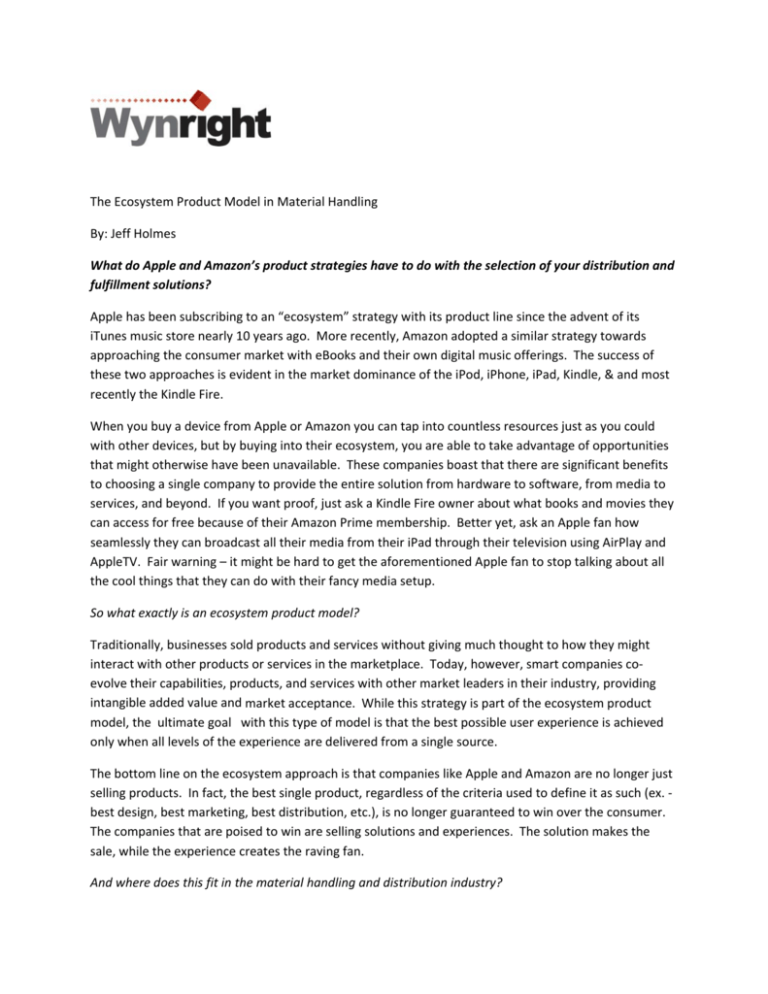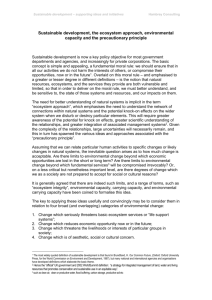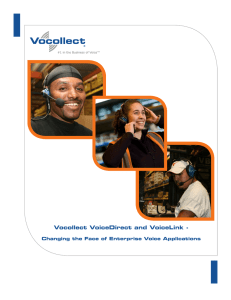The Ecosystem Product Model in Material Handling By
advertisement

The Ecosystem Product Model in Material Handling By: Jeff Holmes What do Apple and Amazon’s product strategies have to do with the selection of your distribution and fulfillment solutions? Apple has been subscribing to an “ecosystem” strategy with its product line since the advent of its iTunes music store nearly 10 years ago. More recently, Amazon adopted a similar strategy towards approaching the consumer market with eBooks and their own digital music offerings. The success of these two approaches is evident in the market dominance of the iPod, iPhone, iPad, Kindle, & and most recently the Kindle Fire. When you buy a device from Apple or Amazon you can tap into countless resources just as you could with other devices, but by buying into their ecosystem, you are able to take advantage of opportunities that might otherwise have been unavailable. These companies boast that there are significant benefits to choosing a single company to provide the entire solution from hardware to software, from media to services, and beyond. If you want proof, just ask a Kindle Fire owner about what books and movies they can access for free because of their Amazon Prime membership. Better yet, ask an Apple fan how seamlessly they can broadcast all their media from their iPad through their television using AirPlay and AppleTV. Fair warning – it might be hard to get the aforementioned Apple fan to stop talking about all the cool things that they can do with their fancy media setup. So what exactly is an ecosystem product model? Traditionally, businesses sold products and services without giving much thought to how they might interact with other products or services in the marketplace. Today, however, smart companies co‐ evolve their capabilities, products, and services with other market leaders in their industry, providing intangible added value and market acceptance. While this strategy is part of the ecosystem product model, the ultimate goal with this type of model is that the best possible user experience is achieved only when all levels of the experience are delivered from a single source. The bottom line on the ecosystem approach is that companies like Apple and Amazon are no longer just selling products. In fact, the best single product, regardless of the criteria used to define it as such (ex. ‐ best design, best marketing, best distribution, etc.), is no longer guaranteed to win over the consumer. The companies that are poised to win are selling solutions and experiences. The solution makes the sale, while the experience creates the raving fan. And where does this fit in the material handling and distribution industry? The ecosystem product model is not exclusive to the consumer oriented companies like Apple and Amazon. This approach to product design is proliferating across many industries including material handling and distribution. Vocollect, the number one developer of voice solutions for mobile workers worldwide, is an example of a company that has successfully used the ecosystem approach with its voice directed line of products. For example, Vocollect will happily let customers run their software on any number of 3rd party devices, but operators will get access to an even greater level of features and functionality when they choose to use the Vocollect Talkman “purpose‐built” devices. Until recently on the integration side of the material handling industry, companies might have sold a conveyor solution to one customer, a robotic system to another customer, and a pick‐to‐light application to a yet another customer. And historically, each one of those systems would have more than likely run on its own standalone software and / or controls. Today, the trend is migrating away from companies marketing a single product to each of its end customers. The transition in the material handling industry from equipment sellers to solution providers is under way and there are plenty of benefits that become available within a distribution or fulfillment center once an operation buys into a fully integrated ecosystem. Let’s first look at the advantages that come with the consolidation of multiple software packages to a single encompassing WCS architecture that uses a modular approach for each of its products. A properly designed modular WCS will be built around a low‐level system layer that includes the interaction with WMS / ERP systems as well as the underlying database for all its “snap‐on” modules. This means that once an operation has one module in place, it becomes less of an effort to add the next one. On day one, one facility might only need a voice selection solution to solve their current needs. Two years later, the same facility might decide to add conveyor or an AS/RS system to support order growth or SKU proliferation. With a modular WCS, the sometimes daunting process of incorporating a new technology becomes less intimidating since it will not require a true “start from scratch” integration effort with a new software package or vendor. On top of the extensibility benefits, there are also inherent benefits that are available when information is shared between one module and another. For example, in a traditional pick‐and‐pass conveyor solution, the number of boxes sitting in queue in a pick zone would typically be the trigger for a conveyor system to stop diverting cartons into a zone, but the truth is that the number of boxes alone does not tell the entire story. Even in a system that has a somewhat predictable number of lines per carton, a random batch of ten cartons will result in variable amounts of work for the selectors in that zone. Depending on order profiles, this variability could result in significantly different workloads if cartons are distributed equally to zones on a keep full basis. If the routing system and the picking system are both under the control of the same WCS, a more intelligent decision can be made that takes into account the actual volume of pending work in a zone and not just carton count. This allows the routing module to deliver a more accurate balance of workload across multiple picking zones. Next, consider the interactions required between a WCS and the underlying machine control sub‐ systems (ie ‐ PLCs, robots, etc.). In essence, the machine control layer is another level of software. The main differentiator is that machine control software is typically written in an open source non‐ proprietary programming language. This leads many warehouse operators to assume that the machine control solution is a commodity that could be provided by any controls house. Following an ecosystem product approach, operators will see inherent benefits from the choice of single source for the WCS and machine control layer. While any third party controls shop might be able to provide the PLC or robotic programming for a solution, it is only when the WCS and machine control teams work together, that they can provide a truly seamless solution. Typically, companies that provide both software and machine level controls have standards in place for sortation decision points, pick and pass transfers, and even robotic palletizing recipe management. These standards lead to “drag and drop” functionality from the machine control layer up to the WCS layer and vice versa. Additional benefits might include native and consistent visibility to alerts, alarms, statistics, and more across all levels of a solution. As was noted in the product models of Apple, Amazon, and Vocollect, there are inherent advantages that come with looking to a single provider for both the software and the hardware requirements of an integrated material handling solution. Within a product ecosystem, hardware and software is tested, proven, and certified to function in an optimal manner when working together. From Pick‐to‐Light hardware to Multi‐Belt Sorters to Bi‐Directional Transfers, it is important to take the same top to bottom modular approach as used in software development models. While it is a bit of a stretch to use the term “drag and drop” when it comes to a mechanical solution like a sorter, the reality is that the entire implementation process benefits from having a single source provider from the mechanical equipment on up to the graphical user interface. Just like the machine control layer, standards that flow from nuts‐ and‐bolts all the way up to ones‐and‐zeroes lead to cleaner implementations and reliable and predictable levels of performance. Finally, buying into an ecosystem product model adds value on the service and support side of operations. Projects flow smoother when all aspects of the job flow through one vendor. Project managers and business analysts have standard tools and methodologies that are well established and familiar across the enterprise. Similar advantages are also common in the realm of aftermarket support. Standards and consistency in design, implementation, and documentation help support representatives troubleshoot faster to address problems that might arise on critical systems. The bottom line is that while material handling system providers do not target the consumer market like Apple and Amazon, the same product development methodologies apply. The result of the ecosystem product model is the availability of true solutions to operational challenges. Once implemented, the solutions help creating lasting partnerships between vendors and their customers – and hopefully result in raving fans!









